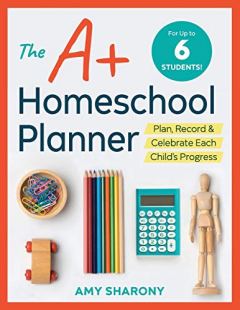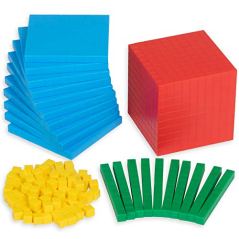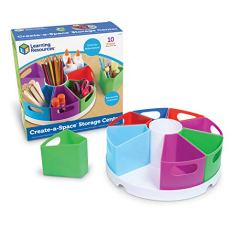BestReviews is reader-supported and may earn an affiliate commission. Details

A planner with few frills but plenty of space and organization to keep your school year on track.
Paperback planner for up to 6 children. Map out lessons by month and week, or use to record progress. Space to record attendance and grades. Colored edges help you find various sections quickly. Uncluttered and straightforward.
Spiral binding would make this organizer more practical.

Protect your wallet and the environment with this two-sided dry erase board for daily lessons.
Two-sided: a lined side for teaching language arts subjects and an unlined side for teaching math. Sturdy and portable. Easy to hold on a table or lap for teaching.
Corners tend to damage easily, especially if dropped or wet.

A lifesaver for teaching many abstract beginner and intermediate math concepts.
Works well for Common Core and traditional math teaching. Helpful for addition, subtraction, carrying, and more. Great for showing decimals and cubic measurements. Bright colors capture students' attention. No sharp edges.
It might be helpful to have more 10-rods.

A versatile chart you can adapt for calendar, scheduling, phonics, or other flexible use.
Seven full rows hold small letter cards, large word cards, days of the week. and more. Rods at top and bottom help to hold it straight. Hang using grommets.
Green color may not be the best with home decor.

Keep your school supplies accessible but contained in this whimsically colored bin.
Space for glue, pencils, crayons, scissors, craft supplies, and more. Removable bins let you take the supplies where you need them. Each section has wide opening for grab-and-go use.
Carousel does not rotate for easy access. May be wide for some surface areas.

We recommend these products based on an intensive research process that's designed to cut through the noise and find the top products in this space. Guided by experts, we spend hours looking into the factors that matter, to bring you these selections.

Are you considering homeschooling or distance learning for your kids? If you are, you’re probably wondering how to set up a productive learning environment. A great starting point is assembling a well-rounded homeschooling kit.
Seeing planners, whiteboards, manipulatives, visual aids, and organizational tools in classrooms is common. These simple yet essential items help kids and parents stay on track with learning goals. They invite kids to be fully hands-on when it comes to personal organization and time management. Furthermore, they set the tone of the learning space. By seeing familiar tools and items from the classroom, kids are more inclined to get in the right headspace for learning.
We cover popular product categories and share plenty of tips to help you maximize the benefits of these products.

Before you begin assembling a homeschooling kit, it’s important to think about the learning space itself.
It’s recommended that you distinguish the learning space from other areas of your home as best you can. By compartmentalizing learning, kids are more inclined to embrace a learning mindset within the space.
It’s helpful to set up a dedicated learning nook or alcove that looks different from your child’s sleeping, eating, and play areas. This can be done using visual aids or by setting up school-themed decor.
The most successful learning spaces are distraction-free. If possible, choose an area where learners won’t be distracted by noise and other interruptions.
For homes with multiple students, it is sometimes beneficial to set up learning spaces apart from one another. This helps keep noise to a minimum, especially when one or more students are participating in class via video.
The at-home learning space should have furniture that is accommodating enough for kids to sit comfortably for a few hours at a time. With that said, overly comfortable furniture might not be conducive to learning because it’s too casual.
Focus on furnishing the space with desks and chairs that strike a balance between functionality and comfort. Some kids also benefit from ergonomic setups that alleviate stress and tension caused by poor posture or uncomfortable sitting positions.
A well-rounded homeschooling kit includes a diverse assortment of accessories and tools, but how do you know which ones are best? To narrow your search, round up age-appropriate and grade-appropriate options. Some visual aids may be too childish for older students, whereas some manipulatives may be too advanced for younger students.
Next, focus on what is functional to keep clutter to a minimum. If you’re not sure how a tool or accessory would benefit the learning situation, eliminate it. If you can immediately identify how it would help your child, keep it.
Another consideration is versatility. While it’s helpful to have accessories and tools with a variety of applications, such as pocket charts, singular focus items, like manipulatives, serve an important purpose as well. With these, kids can clearly see how and when to use them in lessons.

There are countless accessories and tools you can incorporate into your homeschooling kit. We’ve chosen some of the most popular ones that cover the needs of most students. By assembling a kit with these foundational items, it will be invariably easier to select accessories and tools that complement them.
The first item to add to your homeschooling kit is a planner of some kind. Use it to record grades, progress, and assignments so kids stay on track with learning objectives. More than anything, it helps keep day-to-day work organized so it’s smooth sailing through each marking period.
Some parents invest in a teacher planner for detailed tracking. Scheduling charts are popular to hang in learning spaces, as kids can track their progress on a daily, weekly, or monthly basis.
The classic whiteboard is a staple classroom tool that earns a place in a homeschooling kit. Not only do they provide an interactive element for learning, they’re especially helpful for developing math, handwriting, and art skills.
Of course, not every learning space is large enough for a mounted or wheeled whiteboard. Some parents choose smaller whiteboards that can be placed on the floor or leaned against a wall for writing. There are also dry-erase lap boards, which are ideal if space is limited.
Manipulatives are materials or objects that invite students to explore mathematical concepts or ideas with their own hands. They add a physical dimension to learning and have a universal and fun appeal.
Popular manipulatives include interlocking blocks, 2D and 3D geometric tiles, play money, interactive clocks, and pegboards. Many of these come with activity guides that explain how to properly utilize the manipulatives. Extended resources with other games, activities, and projects that involve manipulatives can be found online or in your child’s math textbook.
Visual aids can boost the aesthetic appeal of your child’s learning space. While they appear decorative, they actually serve as static points of reference. As kids work through lessons, the aids can help clarify some questions without kids having to flip through a book or search online.
Popular visual aids consist of anchor charts, pocket charts, and diagrams, to name a few. Some have printed or illustrated information. Three-dimensional options, such as human skeleton models and illuminated globes, are also effective at bringing ideas to life.
Organizational tools keep the learning space tidy. Many teachers agree a clean workspace fosters productive learning sessions. These tools also instill a sense of personal responsibility because kids must return items to specific drawers, compartments, or cubbies.
Of all accessories and tools on this list, organizational materials are by far the most diverse. Filing cabinets, folders, and stacking trays are great to keep homework organized. Art supplies are often kept in pencil cases or storage bin systems. Regularly accessed items like scissors, pencils, and glue are best kept inside a drawer or desk organizer.
Since every family has a different budget, we will explore what you can get in several price buckets. In general, it can cost from $60 to $350 to assemble the items you need.
If you’re on a tight budget, you can build a simple homeschooling kit for $60 to $100. Foundational accessories such as a planner, whiteboard, manipulatives, visual aids, and organizers are found here. To truly stay within budget, however, you’d likely need to choose one item to splurge on and stick to cost-effective options for the rest.
For $100 to $200, you can get some top-quality accessories and tools, many of which are manufactured by leading educational companies. You’ll also have enough room in your budget to invest in a few additional tools or accessories.
If your budget is $200 to $350, you’ll be able to invest in a diverse assortment of accessories and tools, some of which can be reused for more than one school year. Many of these tools and accessories are full-size versions, such as whiteboards or full classroom sets of visual aids.
Note that if you have multiple children, you will be able to share some items with the bunch, such as a pencil sharpener or a whiteboard. However, you will need multiples of items that cannot be shared, such as individual student planners and grade-level workbooks.

A. Both approaches are fine, provided you have the core tools and accessories you need to start the school year. As kids become acquainted with their day-to-day school activities, parents will be able to make purchases tailored to the needs of specific subjects and learning objectives.
A. Most kids enjoy working with manipulatives. With that said, certain manipulatives may be more appealing than others. Kids who enjoy playing with blocks or bricks often enjoy stacking manipulatives, while kids who enjoy simulated play will have fun with play money or cash registers.
A. Most educational items are marked with an ascribed difficulty level or intended grade or age group. Organizational and storage items aren’t normally marked this way since they’re intended for all ages. With that said, some may be better suited for children than others. For example, items with bright colors may appeal more to the younger set.
Get emails you’ll love.
Learn about the products you’re wondering if you should buy and get advice on using your latest purchases.
